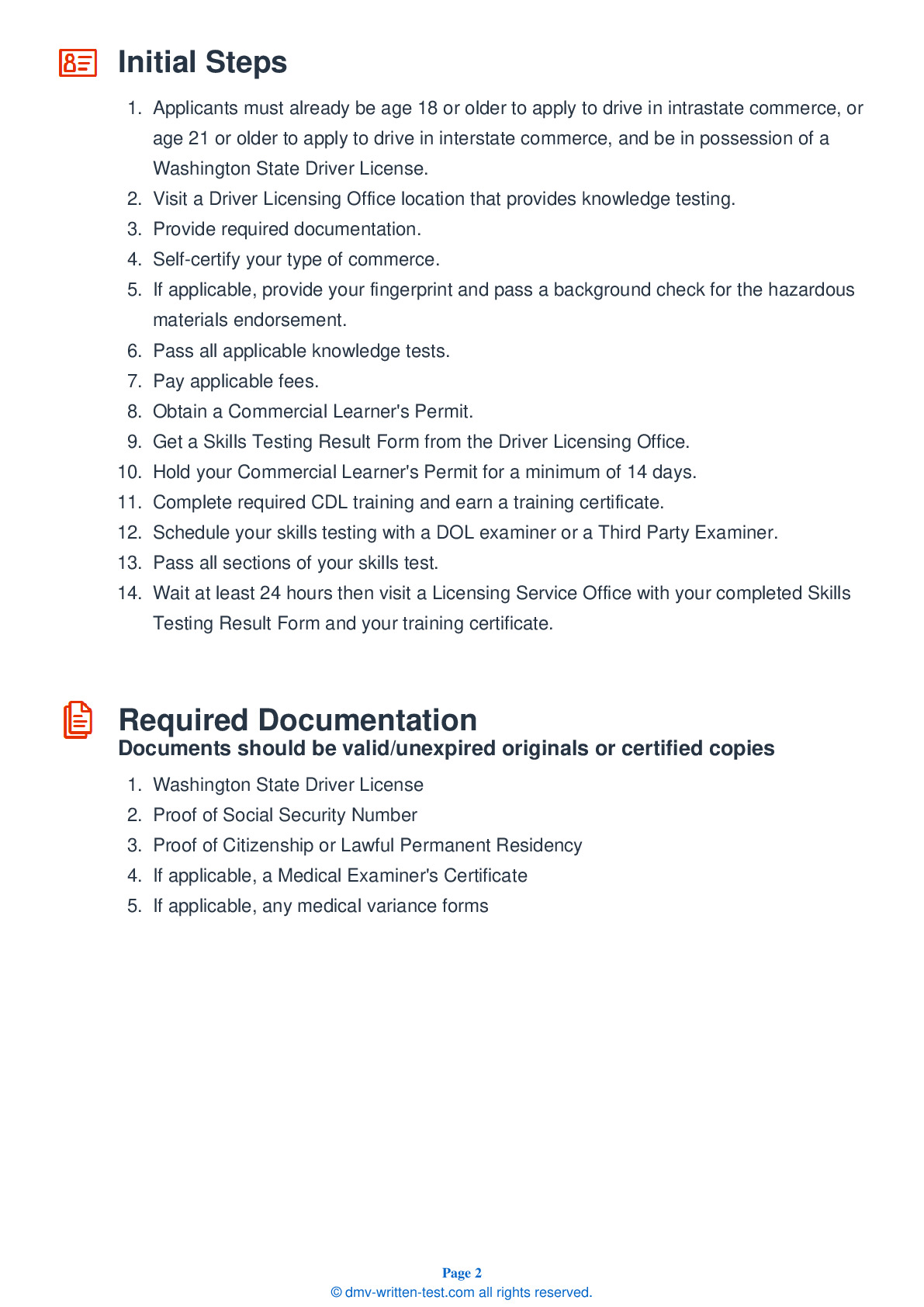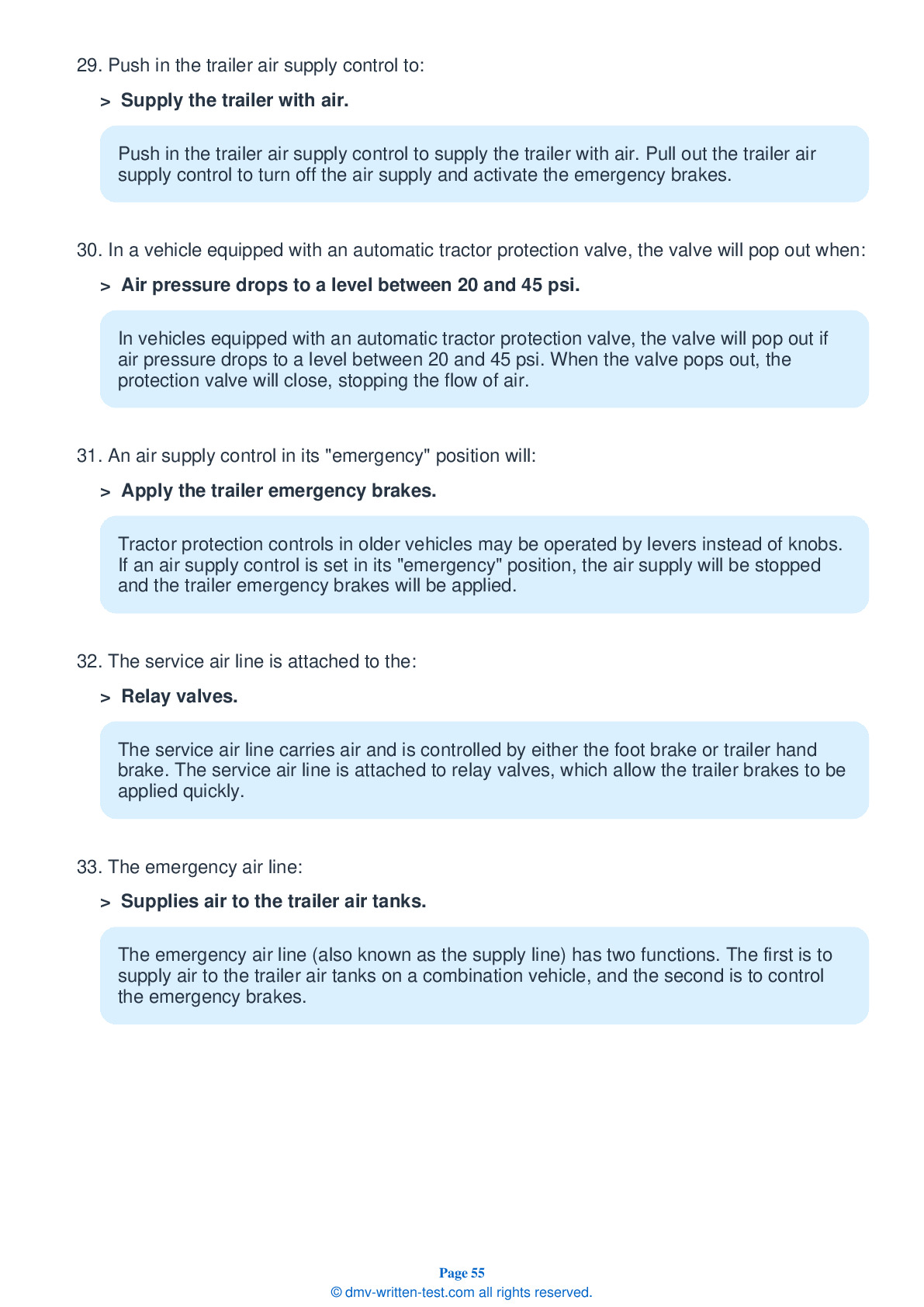Knowledge Test Class B
This license is required for driving a single vehicle with a GVWR of more than 26,001 pounds, and a trailer not to exceed 10,000 pounds gross vehicle weight rating, or a vehicle designed to transport 24 or more people (including the driver). To receive this license, applicants must pass a 50-question test. To pass, applicants must answer 40 questions correctly. Each question has three possible answer choices. Test questions come from the Commercial Driver Guide. Questions come from chapters covering: Introduction, Driving Safely, Transporting Cargo Safely, Air Brakes (if applicable), Pre-Trip Vehicle Inspection Test, Basic Vehicle Control Skills Test and On-Road Driving. Endorsements that may be used with a Class B CDL are: Hazardous materials, Tank, Passenger, HazMat and Tank, Air Brakes and School bus.
29. A driver can rely on front wheel braking to work:
Front wheel braking is effective under all road conditions. It is unlikely that you will experience a front wheel skid, even on ice.
30. If a load is 40 feet long, it should be secured by at least ____ tie-downs.
Cargo should be restrained by at least one tie-down for every 10 feet of cargo. However, all cargo should have at least two tie-downs, no matter the size of the cargo.
31. What is the legal length limit for double-trailer combinations?
In Washington State, a double-trailer combination may not exceed 61 feet in length.
32. When trying to put out an electrical fire, you should:
B:C fire extinguishers are designed to work on electrical fires and burning liquids. Don't pour water on an electrical fire.
33. If the low air pressure warning signal comes on in a vehicle with air brakes, the driver should:
If the low air pressure warning signal comes on while you are operating a vehicle with air brakes, you should stop and safely park the vehicle as soon as possible. It is essential that you are able to stop safely while you still have some braking power remaining.
34. If you are driving at a reduced speed in a construction zone when you spot a construction worker near the road, you should:
Always decrease your speed when traveling through a construction area. Slow down even further if there are workers on or near the roadway.
35. When parked on a flat surface, you should:
When parking on a level surface, you should use wheel chocks. If the vehicle is not equipped with spring brakes, this is essential to prevent the trailer from moving.
Frequently Asked Questions
To obtain a Class B CDL in Washington, the following steps must be taken:
1. Obtain a Washington State commercial driver's license application form from a local Department of Licensing (DOL) office or online.
2. Complete the application form and provide necessary identification documents such as proof of residency, social security number, and proof of legal presence in the U.S.
3. Pass a medical examination and obtain a medical certificate from an approved medical examiner.
4. Pass the knowledge test for the Class B CDL, which includes general knowledge questions about commercial driving as well as specific questions about the type of vehicle you will be driving.
5. Obtain a learner's permit and practice driving with a qualified CDL holder.
6. Pass the skills test, which includes a pre-trip inspection, basic vehicle control skills test, and an on-road driving test.
7. Pay the required fees and receive your Class B CDL from the DOL.
It is important to note that there are additional requirements for operating specific types of vehicles or transporting certain types of cargo. It is recommended to consult with the DOL or a qualified driving school for more information on these requirements.
Specifically, Class B CDL holders can drive the following types of vehicles:
- Straight trucks or buses, including city buses, school buses, and tourist buses
- Segmental buses
- Large farm vehicles
- Dump trucks with small trailers
- Box trucks
- Delivery trucks
- Tow trucks that are not for hire
It is important to note that if you plan to transport hazardous materials or operate vehicles designed to carry 16 or more passengers (including the driver), additional endorsements may be required.
1. Be at least 18 years old to drive within the state of Washington and 21 years old to drive interstate or transport hazardous materials.
2. Hold a valid Washington State driver's license.
3. Provide proof of your identity, lawful U.S. presence or citizenship, and Washington state residency.
4. Pass a Department of Transportation (DOT) physical exam and obtain a medical certificate from an approved medical examiner.
5. Pass the knowledge test for the Class B CDL, which includes general knowledge questions about commercial driving as well as specific questions about the type of vehicle you will be driving.
6. Obtain a learner's permit and practice driving with a qualified CDL holder.
7. Pass the skills test, which includes a pre-trip inspection, basic vehicle control skills test, and an on-road driving test.
8. Pay the required fees and receive your Class B CDL from the Department of Licensing (DOL).
It is important to note that there may be additional requirements for operating specific types of vehicles or transporting certain types of cargo, such as hazardous materials or passengers. It is recommended to consult with the DOL or a qualified driving school for more information on these requirements.
It is important to note that some employers may have their own age requirements for hiring commercial drivers, which may be higher than the minimum state requirements.
In general, you will need to obtain a Class B CDL with the appropriate endorsements for the following types of vehicles or cargo:
1. Passenger endorsement (P) - Required if you plan to drive a vehicle designed to transport 16 or more passengers (including the driver), such as a bus or large van.
2. School bus endorsement (S) - Required if you plan to drive a school bus.
3. Tanker endorsement (N) - Required if you plan to transport liquids or gases in bulk containers with a capacity of 1,000 gallons or more.
4. Hazardous materials endorsement (H) - Required if you plan to transport hazardous materials, as defined by federal regulations.
5. Combination of tank vehicle and hazardous materials endorsements (X) - Required if you plan to transport both hazardous materials and liquids or gases in bulk containers with a capacity of 1,000 gallons or more.
To obtain these endorsements, you will need to pass additional knowledge and skills tests, in addition to the Class B CDL tests.
1. Pre-trip inspection: You will be asked to do a pre-trip inspection of the vehicle you will be driving, and you must identify and explain to the examiner any potential safety hazards or defects on the vehicle.
2. Basic vehicle control: You will be asked to demonstrate your ability to control the vehicle in various maneuvers, such as straight line backing, offset backing, parallel parking, and docking.
3. On-road driving: You will be asked to drive the vehicle on public roads while following the examiner's instructions and demonstrating your ability to safely operate the vehicle in traffic.
During the skills test, you will be evaluated on your ability to perform each task safely and accurately. You must pass all three parts of the test in order to obtain a Class B CDL.
It is important to note that you must provide your own vehicle for the skills test, which must meet certain requirements and pass an inspection before the test can be administered.
1. Vehicle weight limit: You are only allowed to operate a single vehicle with a gross vehicle weight rating (GVWR) of 26,001 pounds or more.
2. Towing limit: If you plan to tow a vehicle or trailer, the total weight of the towed vehicle(s) cannot exceed 10,000 pounds.
3. Passenger limit: You are only allowed to transport up to 15 passengers (including the driver) if you have a passenger endorsement on your CDL.
4. Hazardous materials restriction: If you transport hazardous materials, you must have a hazardous materials endorsement and comply with all applicable federal and state regulations.
5. Interstate vs. intrastate operation: Depending on your specific driving situation, you may be restricted to operating only within the state of Washington (intrastate), or you may be allowed to operate across state lines (interstate).
It is important to understand and comply with all applicable restrictions and limitations for your Class B CDL license in order to ensure safe and legal operation of your vehicle.
However, if you have difficulty reading or understanding English, you may request an interpreter to assist you during the test. The interpreter must be a qualified third-party individual who is not related to you, and they must be approved by the DOL. You will need to pay for the interpreter's services yourself.
It is important to note that even if you use an interpreter, you will still need to have a good understanding of basic English in order to pass the test. The interpreter can only help with language barriers and cannot assist with answering the questions or interpreting the meaning of the questions.
To request accommodations, you must complete and submit the Request for Reasonable Accommodation form to the DOL. The form can be downloaded from the DOL website or obtained from any driver licensing office. You will need to provide documentation from a qualified professional that verifies your disability and specifies the accommodations you need.
Some examples of accommodations that may be provided include:
- Extended time to complete the test
- A separate testing room
- A reader or scribe
- Assistive technology, such as a screen reader or magnifier
The DOL will review your request and determine what accommodations can be provided based on your specific needs and the resources available. Note that you may need to schedule your test at a specific location that can provide the requested accommodations.
It is important to submit your request well in advance of your desired testing date in order to allow time for the DOL to review and process your request.
If you fail the test three times, you will need to wait at least two weeks before taking it again. If you fail the test four or more times, you will need to wait at least three weeks before taking it again.
Note that each time you retake the test, you will need to pay the testing fee. It is important to study and prepare thoroughly for the test to increase your chances of passing on your first attempt.
If you continue to have difficulty passing the written test, consider seeking assistance from a qualified driving school or instructor who can provide additional instruction and support.




